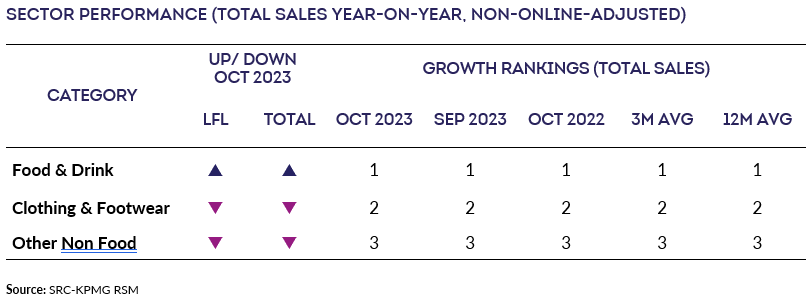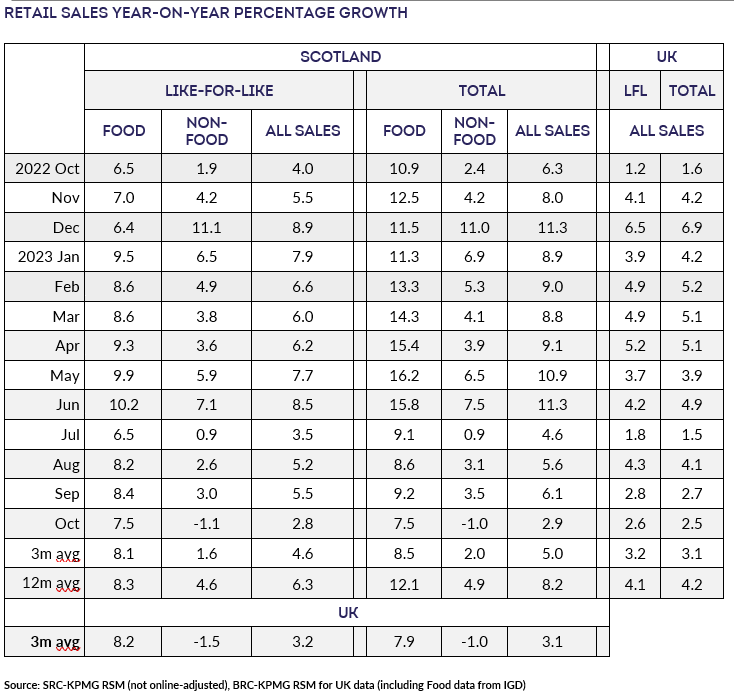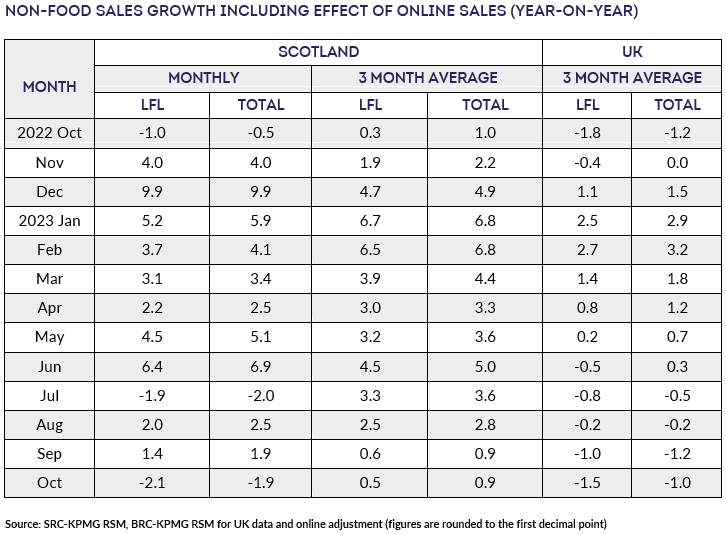Sales figures are not adjusted for inflation. Given that both the
October SPI (BRC) and September CPI (ONS) show inflation running
at above normal levels, a portion of the sales growth will be a
reflection of rising prices rather than increased volumes.
Covering the four weeks 1 – 28 October
2023
- Total sales in Scotland increased by 2.9% compared with
October 2022, when they had grown 6.3%. This was below the
3-month average increase of 5.0% and below the 12-month average
growth of 8.2%. Adjusted for inflation, the year-on-year decline
was 2.3%.
- Scottish sales increased by 2.8% on a Like-for-like basis
compared with October 2022, when they had increased by 4.0%. This
is below the 3-month average increase of 4.6% and the 12-month
average growth of 6.3%.
- Total Food sales increased by 7.5% versus October 2022, when
they had increased by 10.9%. October was below the 3-month
average growth of 8.5% and the 12-month average growth of 12.1%.
The 3-month average was below the UK level of 7.9%.
- Total Non-Food sales decreased by 1.0% in October compared
with October 2022, when they had increased by 2.4%. This was
below the 3-month average increase of 2.0% and the 12-month
average of 4.9%.
- Adjusted for the estimated effect of Online sales, Total
Non-Food sales decreased by 1.9% in October versus October 2022,
when they had decreased by 0.5%. This is below the 3-month
average growth of 0.9% and the 12-month average of 3.7%.
David Lonsdale, Director | Scottish Retail Consortium
“Severe storms and repeated deluges and disruptions combined with
lingering cost-of-living concerns to put a real dampener on
Scottish retail sales last month. It was a miserable start to
retail’s golden quarter. The significant weakening was the
poorest monthly performance since July and a fourth consecutive
month of real terms decline in the value of retail sales.
“The downturn was seen across all categories but was particularly
pronounced in non-food, which saw its first decline since May.
The growth in grocery sales continued to reduce, mirroring the
fall in food price inflation. Lower-priced indulgencies such as
cosmetics and fragrances fared well, as did sales of Wellington
boots and cold and flu remedies perhaps unsurprisingly given the
drookit conditions. Formalwear was a bright spot as people
returned to corporate events and prepared for the looming party
season, but clothing overall suffered as did sales of larger
ticket items including white goods, electricals, and furniture.
“Hopefully, the downturn in sales is only temporary. That said,
it may continue for a little while yet as indications are that
households are delaying Christmas-related spending in the hope of
grabbing a bargain during Black Friday discounting. With
consumers so price-sensitive it is critical that the Chancellor
and Finance Secretary in their upcoming Budgets seek to support
consumer confidence whilst helping retailers to keep down prices
at the tills. The marked deceleration in shop price inflation
should assist, as should the temporary discounts to peak rail
fares and mooted council tax freeze. However, we need to see
Ministers rule out a hike in the business rate which would add
significantly to shopkeepers’ outgoings and put upward pressure
on prices for consumers.”
, Partner, UK Head of
Retail | KPMG
“Retail sales remained weak in October with growth of just 2.9%
in Scotland, although food and drink and some health and beauty
categories continued to drive sales. Online sales continued to
struggle compared to the same period last year, which could
herald the most competitive Black Friday period that we’ve seen
in a while.
"Despite a decrease in inflation compared to last October's peak
of over 11%, the past 12 months have impacted consumer confidence
and spending ability. With higher interest rates, diminished
COVID savings, and increased heating costs, consumers are now
cautious about their expenditures. This has led to a decline in
the strong demand that sustained some retailers over the past 18
months.
“The upcoming Christmas season poses challenges for retailers as
they compete for a shrinking share of consumer spending through
promotions, further squeezing already tight margins. Anticipated
lower spending levels make this Christmas season potentially the
most challenging since before the pandemic."



